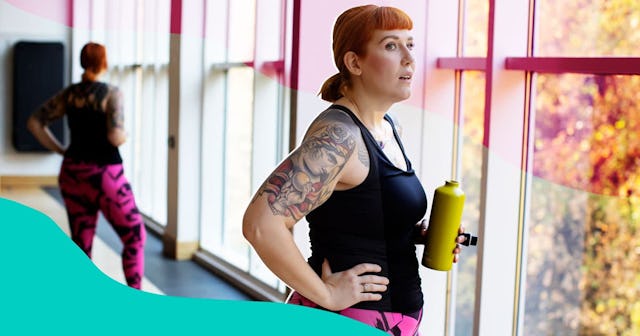I Didn't Realize My Internalized Fat Phobia--Until I Had A Child

At 11 p.m., I was googling “Christina Applegate plastic surgery.” I had just finished binge-watching Netflix’s Dead to Me and was in awe of Christina’s beauty and physique. Her slender frame would be enviable on a woman half her age.
Why was I scouring gossip sites? Did I want to learn whether Christina has gone under the knife or not? Whether natural beauty is possible or a fantasy? I wasn’t sure.
What I was sure about: everything about my body changed after I had a baby. I had always been fairly thin and had never monitored my weight. Most of us probably don’t get out a yard stick to measure our height regularly. Stepping on a scale each week would have felt just as alien to me.
After my daughter was born, my pregnancy weight fell right off. In my family’s newborn photo shoot, taken when my little girl was just 12 days old, I look like my pre-pregnancy self. I was puzzled by moms who continued to grapple with “baby weight” long after the baby was born. Baby weight, I was convinced, was just the weight of the baby and her environment.
Bryan Cordova/Reshot
Dangerously, the weight kept coming off. Stress, pumping and breastfeeding, and zero time to care for myself drove my weight down to a scary 95 pounds before I even noticed. After that, I started adding coconut oil to my morning oatmeal and drinking peanut butter fudge milkshakes. My weight returned to normal and I stopped paying attention again.
About two and a half years after my baby was born, three things happened at once: I stopped breastfeeding, I started taking two new medications for postpartum conditions, and I gained about 15 pounds. For the first time, I understood how it felt to gain weight seemingly from nowhere.
Weight is just a number, I tried to reassure myself. It’s not who you are. But I didn’t believe it. Over the course of a lifetime, I had internalized my identity as a thin person in profound and unhealthy ways without realizing it.
When I was thin, I identified my hiding place in the event of a shooter in my office, a cranny between the wall and the copy machine in the supply room, and congratulated myself on being small enough to fit – and, thus, worthy of surviving. I joked about securing my attendance at meetings that were already overbooked by saying, “I won’t take up much room.” The message I reinforced for myself was: “I’m thin: I deserve to belong.”
Then, in the midst of my child’s toddlerhood, I was confronted with a new body. Yo-yo’ing weight had left a mark. I felt soft and deflated. My jokes rang hollow and my skinny person wardrobe no longer fit.
Over the course of a lifetime, I had internalized my identity as a thin person in profound and unhealthy ways without realizing it.
I knew I needed perspective and googling Christina Applegate wasn’t going to provide it. A healthier attitude was critical because there was, and is, another body I care very much about: my daughter’s. At age three, she twirls, somersaults, and jumps with wild abandon, living fully in every inch of her body. I want her to grow up loving her body, whatever shape it takes, which means I need to act as a role model and love my own.
Reshot
My post-pregnancy body posed a painful question and my daughter provided the healing answer. How can I love a body that feels destroyed? By looking at it through my daughter’s eyes. The palm of my gently cupped hand is a place to rest her cheek on a long car ride. My legs are a slide from the armchair to the floor. The small of my back is the seat of a motorcycle or the back of a horse. My lap is the safest place in the world, my arms can squeeze away sadness, and my lips can kiss away pain.
Perhaps best of all, my body brought this twirling, somersaulting, jumping child into the world. My body held her, fed her, and kept her safe for the first nine months and beyond.
My post-pregnancy body posed a painful question and my daughter provided the healing answer. How can I love a body that feels destroyed? By looking at it through my daughter’s eyes.
When I play with my daughter, I swing her around and tip her upside down. As her laughter bubbles up at me, I know that we are both wonderfully made.
This article was originally published on